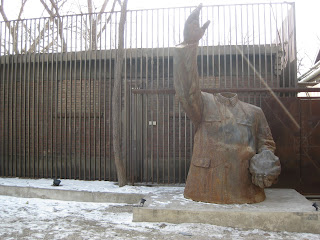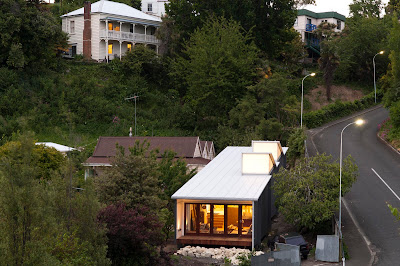One of the best things to see in Beijing is the city's 798 art district, a fantastic area of old factories and warehouses now occupied by contemporary art galleries. I was there in February, marvelling at how contemporary art appears to be flourishing in what's supposed to be an authoritarian state. But first, a bit of an apology, as I was not as diligent as I should have been in writing down who the works you're about to see are by.
Someone at 798 told me a story about the sculpture in the image below that provided an amusing insight into the to-and-fro negotiation of what constitutes appropriate artistic expression in China. Apparently at one stage the state requested that artists stop using Mao's head in their works. The sculpture below was a response to that, which many critics took to be a suggestion that the state was headless. Then the goverment purchased one of the works in this series for the national collection, saying it believed the headless sculpture meant the government represented all the people equally. As far as I know, the artist didn't step in to say which interpretation was correct.
One of the best galleries at 798 is the Ullens Centre for Contemporary Art (UCCA), established by European philanthropists. The exhibition below is named 'Moon in Glass' by artist Ling Jian and features portraits printed onto coloured mirrors. As you get closer, the images of the faces appear to recede, and you see your own reflection instead. What seemed like a glossy pop-art take on modern China was also working on other intriguing levels.
Also at UCCA, a fantastic show by painter Liu Xiaodong entitled 'Hometown Boy'. Liu went to stay in his old hometown for a period of a few months and painted beautiful, gentle scenes of his parents and childhood friends there. The show was accompanied by Liu's diary of his experience there, as well as an hour-long documentary by Taiwanese filmmaker Hou Hsiao-hsien that showed Liu working and interacting with his friends. The exhibition was, in part, a lament for the simpler style of life Liu believes China has lost - the state-run factory that used to employ most people in his hometown has laid off hundreds of workers, and many others have left to find work in the bigger cities. The exhibition raised questions about the price of China's recent economic progress.
The next few images show the amazing buildings at 798 (which I think date from the 1960s), and the juxtaposition of the contemporary sculptures outside them. As you can see in one of the shots, the area is also used as a backdrop for bridal shoots.
This fantastic building below contains Pace Beijing gallery, another of 798's main attractions - not just for the architecture, but the art inside.
This industrial structure loomed across the courtyard from Pace - I'm not sure who did the sculpture on the building behind it.
And I think that's all the holiday shots I have to show you - I hope I haven't bombarded the blog with too much Beijing. I've also written a travel story about the city for Kia Ora (the Air New Zealand inflight magazine) which comes out soon. And one of the hotels I stayed at, The Opposite House (designed by Japanese architect Kengo Kuma) is covered in the April/May issue of HOME.
Update: It seems the tone of optimism in this post about contemporary art flourishing in an authoritarian state might be slightly misplaced: the New York Times reports that contemporary artist (and critic of the Chinese government) Ai Wei Wei has been detained. You can read the story at the link here.
Update: It seems the tone of optimism in this post about contemporary art flourishing in an authoritarian state might be slightly misplaced: the New York Times reports that contemporary artist (and critic of the Chinese government) Ai Wei Wei has been detained. You can read the story at the link here.




















